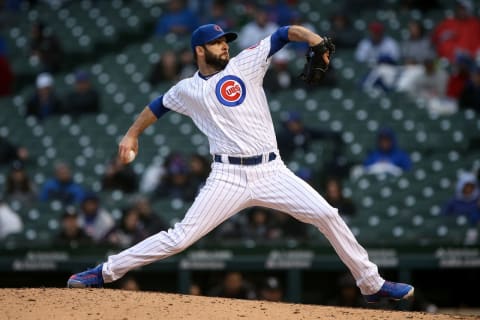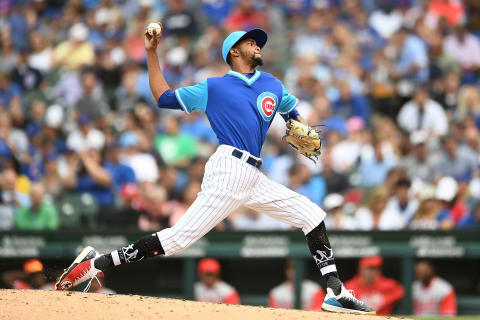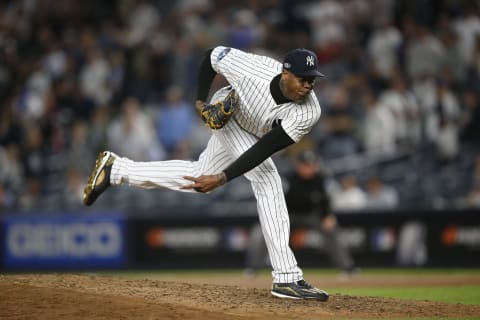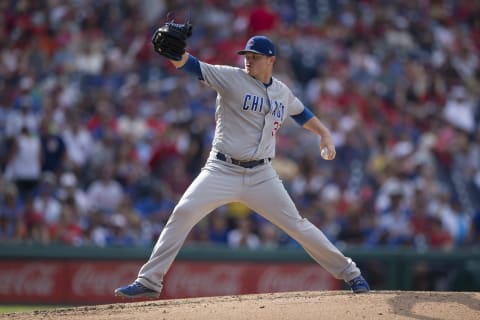Chicago Cubs: Who will join Pedro Strop and Brad Brach in the bullpen?


The Chicago Cubs will hold a competition in Spring Training for numerous bullpen openings, but who will be available to take the mound in relief when the season begins on March 28th in Texas?
Last off-season, the Chicago Cubs signed Brandon Morrow (two-years, $21.00 million), Steve Cishek (two-years, $13.00 million), Brian Duensing (two-years $7.00 million), Shae Simmons (one-year, $750 thousand), and Dario Alvarez (one-year, $545 thousand) in an attempt to fortify their bullpen. The team also added Drew Smyly (two-years, $7.00 million) to serve in relief if there was not an available spot in the starting rotation.
The team also claimed Randy Rosario off of waivers from the Minnesota Twins and Cory Mazzoni off of waivers from the San Diego Padres. Anthony Bass, Kyle Ryan, Michael Roth, Danny Hultzen, and Allen Webster were also added during the off-season on minor league contracts.
Despite a number of notable additions, the team saw Wade Davis depart to the Colorado Rockies and Hector Rondon depart to the Houston Astros. Koji Uehara also left the team in favor of returning to the Japan Central League as a member of the Yomiuri Giants, where he spent the first 10 years of his professional career.
As many top relievers left the team, additional reinforcements were desperately needed alongside returning relievers such as Pedro Strop, Carl Edwards Jr. Justin Wilson, and Justin Grimm. Although Cishek and Rosario performed well during each of their first seasons in Chicago, the remainder of the new additions did not have much of an impact last season.
For example, Morrow was only able to appear in 35 games, Smyly was unable to make an appearance, and Duensing compiled a dismal 7.65 earned run average. Nonetheless, before we take a look at the newly added relief pitchers for the upcoming bullpen competition during Spring Training, let’s take a look at how the Cubs’ bullpen performed last season.

The Chicago Cubs went through twenty-eight relief pitchers (two of which were position players) last season, but they were only able to compile a team WAR that ranked near the middle of the league.
During the 2018 regular season, the Chicago Cubs‘ bullpen ranked 12th throughout Major League Baseball in terms of wins above replacement (WAR) at 4.0 (FanGraphs link). The top individual performers last season were Carl Edwards Jr.(1.1 WAR), Jesse Chavez (1.0 WAR), Pedro Strop (0.8 WAR), and Steve Cishek (0.8 WAR).
Brandon Morrow compiled a 0.6 WAR last season while Justin Wilson and Jorge De La Rosa each added a 0.5 WAR of their own to the team total. The remaining 0.8 WAR was spread out between Anthony Bass (0.2), James Norwood (0.2), Alec Mills (0.1), Jaime Garcia (0.1), Eddie Butler (0.1), and Cory Mazzoni (0.1).
Mike Montgomery, Justin Hancock, and Rob Zastryzny each held a 0.0 WAR during their time in relief last season. Montgomery, Hancock, and Zastryzny interestingly shared the same relief WAR as Anthony Rizzo (0.1 IP) and Ian Happ (1.0 IP).
Out of other Cubs’ pitchers with at least 15 relief appearances, Luke Farrell, Brandon Kintzler, Randy Rosario, and Brian Duensing all compiled a negative WAR. Farell finished at a -0.1 WAR through 18 appearances, Kintzler finished at a -0.3 WAR through 25 appearances, Rosario finished at -0.3 WAR through 44 appearances, and Duensing finished at a dismal -0.9 WAR through 48 appearances.
Although the WAR statistic is not the only part of being a solid relief pitcher, the WAR leader board is generally accurate in listing the top relief pitchers throughout the MLB. For example, Blake Treinen finished first with a 3.6 WAR, Edwin Diaz finished second with a 3.5 WAR, and Josh Hader finished third with a 2.7 WAR.
A member of the Cubs’ bullpen does not appear on the WAR leader board until Edwards Jr shows up at number forty-two, so this is definitely an area for improvement for the team next season.

Regardless of the team ranking in WAR, the Chicago Cubs finished in the bottom-half of the MLB last season in multiple key areas.
The bullpen of the New York Yankees is well-known for its ability to strike out opposing hitters, which often helps end a rally attempt by the offense of the opposing team. Last season, they finished first in the league with 11.40 strikeouts per nine innings. The Houston Astros were second with a 10.56 K/9 and the Milwaukee Brewers were third with a 10.38 K/9.
Unfortunately for the Chicago Cubs, their bullpen ranked 18th in the league with an 8.63 K/9. Out of the ten MLB teams that reached the postseason in 2018, the Cubs’ bullpen ranked last in K/9.
As it is very important to keep free passes to a minimum in the late innings, the Cubs’ bullpen did an awful job at prevent walks. During the 2018 regular season, there were only three teams with a higher walks allowed per nine innings. The Atlanta Braves held a league-worst 4.41 BB/9, the St Louis Cardinals held a 4.34 BB/9, the Baltimore Orioles held a 4.32 BB/9, and the Cubs held a 4.18 BB/9.
Despite the poor K/9 and BB/9, the Cubs’ bullpen performed very well in batting average on balls in play as well as home runs allowed per nine innings. The Oakland Athletics led the league in BABIP at .265 and the Washington Nationals and Cubs were tied for second at .277. In the HR/9 category, the Cubs took the top spot in the MLB by allowing a minuscule 0.78 HR/9.

Despite the overall team stats, there were quite a few solid individual performances that played a role in the Chicago Cubs earning a spot in the National League Wild Card game.
Out of the twenty-eight relief pitchers used by the Chicago Cubs last season, Steve Cishek, Pedro Strop, Justin Wilson and Carl Edwards Jr.were the standouts. Cishek compiled a 2.18 ERA, a 3.45 FIP, and a 1.038 WHIP with 78 strikeouts and 4 saves through 70.1 innings pitched. Strop compiled a 2.26 ERA, a 3.43 FIP, and a 0.989 WHIP with 57 strikeouts and 13 saves through 59.2 innings pitched.
Wilson compiled a 3.46 ERA, a 3.64 FIP, and a 1.427 WHIP with 69 strikeouts through 54.2 innings pitched. Edwards Jr compiled a 2.60 ERA, a 2.93 FIP, and a 1.308 WHIP with 67 strikeouts through 52.0 innings pitched. After being signed to a minor league contract prior to the start of last season, Randy Rosario deserves an honorable mention with a 3.66 ERA, 4.68 FIP, and 1.479 WHIP through 46.2 innings pitched.
Anthony Bass also performed well on a minor league contract with a 2.93 ERA, 2.77 FIP, and 1.370 WHIP with 14 strikeouts through 15.1 innings pitched. Following a release from the Arizona Diamondbacks in August, Jorge De La Rosa became a standout performer after he was picked up by the Cubs. Throughout 21.0 innings pitched, he compiled a stellar 1.29 ERA, a 2.40 FIP, and a 1.048 WHIP alongside 20 strikeouts.
Another notable performer was Jesse Chavez after he was acquired from the Texas Rangers prior to the trade deadline in exchange for Tyler Thomas. During his time in Chicago, Chavez put together a phenomenal 1.15 ERA, a 2.39 FIP, and a 0.795 WHIP with 42 strikeouts and 5 walks through 39.0 innings pitched.
Nonetheless, as Brandon Kintzler (7.00 ERA in 25 games) and Brian Duensing (7.65 ERA in 48 games) greatly under performed for the Cubs last season, as Brandon Morrow will miss the start of the season, as Wilson departed to the New York Mets, and as Chavez returned to the Texas Rangers, the Cubs’ bullpen once again needed to locate reinforcements during the off-season.

Although De La Rosa remains a free agent a few days before Spring Training games begin, the front office of the Chicago Cubs made a flurry of moves over the winter in an attempt to strengthen the bullpen.
During the off-season, the Chicago Cubs most notable signings included Brad Brach, Tony Barnette, Xavier Cedeno, and Kendall Graveman. Brach signed a one-year contract worth $4.35 million that includes a dual option for a second season (MLB Trade Rumors link). Barnette signed a one-year contract worth $750 thousand that includes roster incentives and a club option for a second season (MLB Trade Rumors link).
Cedeno signed a one-year contract worth $900 thousand (MLB Trade Rumors link). The contract is non-guaranteed and it includes $300 thousand worth of incentives. Graveman signed a one-year contract worth $575 thousand that includes an escalator cause, additional incentives, and a club option for a second season (MLB Trade Rumors link). Graveman is currently on the disabled list as he is recovering from Tommy John surgery.
The organization added relief pitchers Darling Grullon, Corey Black, Manuel Heredia, Mike Zagurski, Alberto Baldonado, Matt Carasiti, Carlos Ramirez, Colin Rea, George Kontos, Junichi Tazawa, Allen Webster, Christian Bergman, Rob Scahill, and Robert Robbins on minor league agreements.
The Cubs also claimed Jerry Vasto off of waivers from the Kansas City Royals, claimed Ian Clarkin off of waivers from the Chicago White Sox, acquired Rowan Wick in a trade with the San Diego Padre, and acquired Conor Lillis-White in a trade with the Los Angeles Angels. Previously signed internal options Duncan Robinson and Dakota Mekkes were also invited to Spring Training to compete for a 25-man roster spot.
Unfortunately for the Cubs, Justin Wilson and Jesse Chavez were lost during free agency. Wilson signed a two-year, $10.00 million contract with the New York Mets (MLB Trade Rumors link). Chavez signed a two-year, $8.00 million contract with the Texas Rangers (MLB Trade Rumors link). The team also moved Drew Smyly to the Texas Rangers in a trade to clear some salary space (MLB Trade Rumors link).
Nonetheless, due to all of the aforementioned additions, the Cubs will have numerous decisions to make in regards to which relievers leave Spring Training as a member of the 25-man roster.

The Chicago Cubs will likely dedicate eight of their twenty-five roster spots to the bullpen. As five relievers are a lock for a roster spot, there could be as many as three openings for pitchers to compete over during the spring.
Barring any unforeseen trades, injuries, or random incidents, Brad Brach, Steve Cishek, Carl Edwards Jr. Mike Montgomery, and Pedro Strop should be the five relievers that are a lock for a role in the bullpen. As Brandon Morrow is expected to miss at least one-month of the season due to off-season surgery, there will likely be some form of competition between these five pitchers during Spring Training to see who will open the season as the Chicago Cubs‘ closer.
Even though the Cubs have many options to consider throughout Spring Training, there are already front-runners for the open bullpen spots due to certain players already maintaining a spot on the 40-man roster. These players include Albert Alzolay, Tony Barnette, Xavier Cedeno, Brian Duensing, Brandon Kintzler, Dillon Maples, Alec Mills, James Norwood, Randy Rosario, Kyle Ryan, Justin Steele, Jen-Ho Tseng, Duane Underwood Jr. and Rowan Rick.
More from Call to the Pen
- Philadelphia Phillies, ready for a stretch run, bomb St. Louis Cardinals
- Philadelphia Phillies: The 4 players on the franchise’s Mount Rushmore
- Boston Red Sox fans should be upset over Mookie Betts’ comment
- Analyzing the Boston Red Sox trade for Dave Henderson and Spike Owen
- 2023 MLB postseason likely to have a strange look without Yankees, Red Sox, Cardinals
Out of these players, Barnette, Duensing, and Kintzler should be considered the most likely to end up in the bullpen next season. This is due to their previous major league experience alongside their positions on the Cubs’ overall payroll. Although Cedeno is a well-traveled relief pitcher with a solid track record, he could be the odd man out as his salary for the upcoming season is not guaranteed. Despite a solid season in 2018 from Rosario, he may also be on the outside looking in as he can be optioned to the minor leagues following Spring Training.
Duensing and Kintzler had forgettable seasons in 2018, but each reliever is likely to get an opportunity to start the season at the major league level due to previous success for other teams in the MLB. It is also likely that the Cubs will not want to shed their salaries without giving them another opportunity as Duensing is owed $3.50 million and Kintzler is owed $5.00 million next season.
Next. Tyler Chatwood hopes to improve after fixing a mechanical flaw. dark
As Barnette can be optioned to the minor leagues, the Cubs may end up putting a starting pitcher in the bullpen. If all of the starting pitchers are healthy, Tyler Chatwood would likely be the sixth starter, which would relegate him to the bullpen. Due to this, the expected bullpen for the Chicago Cubs to start the 2019 regular season should be Brad Brach, Steve Cishek, Tyler Chatwood, Brian Duensing, Carl Edwards Jr. Brandon Kintzler, Mike Montgomery, and Pedro Strop.